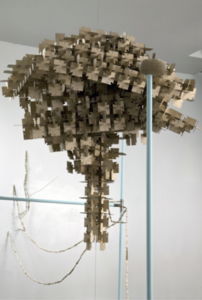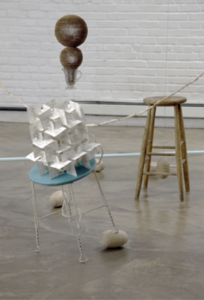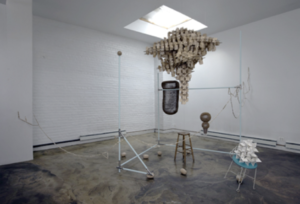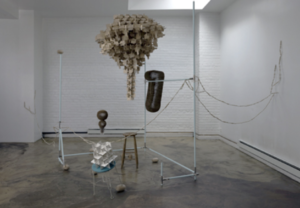Download a PDF of this text
Transcript from Circa Magazine, 2010
Tim Maul interview with Maud Cotter

Maud Cotter: Rumpus room, 2009, installation shot, Point B, Project Space, Williamsburg, New York; courtesy the artist
Tim Maul: My first physical encounter with your work was with Rumpus room, across the river in Williamsburg, Brooklyn at Point B’s exhibition space. My immediate reaction to the piece was a sense of almost Dada portability and of ‘play’. (I am thinking of Duchamp’s mutable, rubber Sculpture for traveling, 1918.) Residencies abroad have stymied several artists I know because they are denied access to the familiar in both their workspaces.
Maud Cotter: Your comment prompts fond memories of Williamsburg and the luxury of play in making Rumpus room. Thanks for the introduction to Duchamp’s Sculpture for traveling – rubber strips cut from bathing caps, randomly assembled and extended with strings, what a brilliant piece. How did I miss it? Stitching oneself into a changing environment makes perfect sense to me. There is a weblike structure in Rumpus room that is woven together with magnets; this is portable, instantly achievable as a form, not unlike Sculpture for traveling, except that it has an element of self-assembly. It is a connector for me, via Rumpus room, with the changing context of the piece. Magnetism is a new conceptual glue for me, it feigns volition, it has its own impish behaviours, and preserves randomness within the piece. I love working with it.
I think the Dadaist reference is relevant as well: the disruption in Rumpus room is a wish to lift the room and its contents into a mercurial condition, away from the norm, suspending their function and meaning. Yes, Rumpus room carries a Dadaist gene. I like to think of it as an antechamber to the reinvention of how we see and function in the physical world.

Maud Cotter: Rumpus room, 2009, installation shot, Point B, Project Space, Williamsburg, New York; courtesy the artist
As to the disruption of routine in the context of residencies, I think the act of change itself provides a stimulus to look at one’s practice as though from a distance. That, to me, is a good place to be, a good place for decision-making and self-criticism. As for the workspace/ laptop scenario, I think of my laptop more as a useful tool; I have come to depend on it for a lot of storage and connection. This is invaluable. I don’t think of it as my workspace; actual space, that active, live, relative entity is where I work.
TM: Many words jump off the page, Maud. The description of magnetic attraction as ‘impish’ could be taken from the Romantic era… Richard Holmes’ book The Age of wonder is high on my 2010 reading list. And ‘rumpus’? Did it derive from ‘rumpus room’ – a space designated for children’s play? I cannot recall that in ’60s Ireland there were such rooms – my family’s living space was very formal, even television watching was like gathering around a hearth. In Where the wild things are Max shouts “Let the Wild Rumpus Start!” which leads to a loss of control… so many art spaces here provide ‘rumpus’ rooms for young artists to act out in…
MC: Perhaps the Romantic strain you picked up on is my attitude to material. I do not think of it as finite, something that is rationalised, measured, predictable and controlled. As a visual artist I preserve my right to see the world anew, and for that I could be labelled ‘romantic’. One of the consequences of this is that my world is one of skepticism and wonder, odd bedfellows. Skeptical about “how things are going” [1], and yes, I still have a sense of wonder at the simplicity and beauty of the ordinary. As science unlocks ever-smaller processes – I am thinking of nano technology here – my wonder just extends to a micro level of consideration. I am reluctant to allow my visual universe to get streamlined by the complex of systems and measures within which we live. I cannot help thinking that when the world becomes even more speedily packaged and spent than it is now, decisions informed by individual vision will be one of the more valid ways forward.

Maud Cotter: Rumpus room, 2009, installation shot, Point B, Project Space, Williamsburg, New York.
Courtesy the artist
As to the origins of Rumpus room, in 2008, while at the Art Fair in Miami, I visited the Wolfsonian Museum. There were two exhibitions on show, the first A Bittersweet decade; The New Deal in America, 1933-43, and the second American streamlined design, the world of tomorrow. Part of theAmerican streamlined design show mentioned the invention of a space called the rumpus room.
I was interested in the invention of a space that absented the order of the rest of the house, “a place where the house lets go…” Vincent Abbott (critic, 1935). The fact that such a form emerged in American culture in a period of recession interested me further. The ‘letting go’ bit interests me more than anything else, inventing a new function within an old form. Americans built a bar, had friends round, danced, watched home movies, played pool table, and generally engaged in activities that they normally did outside the home. I recognised immediately that this form provided me with a space frame within which to cluster ideas, a space with a host of flexible readings. It may be worth repeating a few lines I wrote prior to making the piece:
Rumpus room references the creation of a room in American domestic culture, “a place where the house lets go…” Vincent Abbott (critic,1935). To investigate another revision of form in the context of the domestic is appropriate now, to allow for a new formation of material. The present economic downturn adds an atmosphere of contemplation to this revision. Rumpus Room seeks a mechanism within built structure that will transform it. It seeks an internal system, or series of systems that will, through their expression, release a new energy, prompting a turning of function to other ends. The contents of Rumpus room wishes to turn the notion of the conventional room as container inside out. Framed within a skeletal structure, under the pressure of its contents, Rumpus room will cluster, presenting a desire to break the bonds of the forms that bind us. [2]

Maud Cotter:Rumpus room, 2009, installation shot, Point B, Project Space, Williamsburg, New York; courtesy the artist
TM: Rumpus room has several round stones balanced within it and includes two intricately formed structures that appear attached or ‘caught’ like kites in a tree – so it’s ‘look but don’t touch’. One of the results of the popularity of the art context as family destination is the increased desire for children to interact with sculpture. In the post-minimal era choreographers produced installations and sculptors began to push material around in public. But back to Dada – I am sure that if confronted with Duchamp’s Bicycle wheel (1913) in his studio that one couldn’t resist setting it in motion – since a stool is central to Rumpus room would you agree that there is a performative reading to the piece?
MC: The round elements you refer to are egg shapes. I had about a dozen of them turned in wood with a view to using them as joints for the frame. When I unpacked them and allowed them to spill onto the studio floor, I liked the liquid feel they gave to it, so I left them rest in a languid fashion as they were. I also lifted one into an upper joint of the piece, as originally intended. They remind me of a piece by Anna Maria Maiolino, Entrevidas (on the margin of life) installation, 1981, where she is walking barefoot on a cobbled street through a field of eggs, a wonderfully tentative movement forward. I don’t think that the tension of the floor in Rumpus room would be right without my considerably larger wooden eggs.
The shifting of weight from the physical elements of Rumpus room is an important part of the piece for me. The woven cardboard element is even more tentatively suspended, and is meant to convey a sense of vulnerability. I imagine interaction with the piece as a meeting place in the fabric of the piece and the fabric of the mind of the viewer. The participation and interaction of the two is a plastic interwoven space, more of “knots of relations (connections)” [3] , than a physical relationship.

Maud Cotter: Rumpus room, 2009, installation shot, Point B, Project Space, Williamsburg, New York; courtesy the artist
I don’t think of the piece as a ‘family destination’. My intention was to purposefully remove the family room to another place, in order to view, and review it at a distance. The choreography of the piece to me is more of an entering of the elements into play with other forces. Gabriel Orozco’s The Weight of the sun is lifted and turned in a way that I admire. The performative element of that piece, to me, is that it lifts material into another realm of consideration. I think that performance is integral to all work that engages with three-dimensional space; as Marge of The Simpsons said when looking at a piece of art, “whatever it is doing, it is doing it now.” [4]
TM: I believe that Simpsons episode, where Homer becomes an artist, featured the voice of Jasper Johns – an individual not known for his accessibility. The direct opposite of him is someone like Buckminster Fuller, whom Matt Packer refers to in his essay about you (‘More than one way out’, 2009). The Fuller show at the Whitney Museum here was one of the sleeper hits of 2008 – both utopian and deeply eccentric. It nonetheless underscored Fuller’s belief that his ideas could serve others and offer ‘average’ people a better ‘way of life’. These are perilous times, Maud, and I wonder what you think. As I wander through the juvenile play-spaces that Andrea Zittel constructs for adults I wonder if the artist / practitioner is up to the task…
MC: Are we as artist up to the task of meeting the future? This is a big question, and one that I regularly ask myself. There are a number of issues within my practice that I think are relevant to these ‘perilous times’, and I believe that the work I make is worth the time and materials it takes to make it.
I find Buckminster Fuller’s work very inspiring, his activation of “nature’s architectural inventiveness” [5] in a combination of hexagonal and pentagonal elements extended an evolved structure to new ends. His geodesic domes pointed to a future wherein “most of the problems of mankind could be solved through an efficient use of technology and resources… but the achievement of this goal would require a new cultural attitude and a better method of managing resources.” [6]
My work fits into making shifts in cultural attitude. We have to start at a micro level to enact profound change on a large scale. This focus of realising the unused potential of material by changing the meaning and pattern we attribute to it, is an important part of my work.
Enhancing our intellectual and physical connection to the material world is important.
The insistent waves of experiences that fill our days become more and more vividly commercial, neutralizing our sensitivity and creative energies.
The arts provide a live avenue of reconnection. I am a maker and have chosen to address the object, specifically the domestic object over the last few years. This is an attempt to shift the function and meaning of things at the heart of our everyday lives. This aesthetic process can strip down old meanings and add new ones, remake the given, a sort of aesthetic recycling. Within this idea lies the possibility of slowing down our rate of consumption and production, while formulating new values to govern how we live. Art is slow, well my kind of art is, but I think that the shift in thinking will need to take root in our personal lives and homes.
Another issue that is very much on my mind, and the motivation behindFallen, one of the pieces from my last one-person show, is our potential to genetically design at a level and rate of change that is unprecedented.
The piece does not offer any answers, but suspends my anxiety around this issue, thereby posing some questions, perhaps giving rise to some discussion. The visual arts have the potential to raise questions in a very intimate and critical way. The nature and context of human intervention with an emphasis on the material world is my area of concern. Maybe a selected list of some of the pieces I have made to address this would provide an appropriate ending to this interview.
TM: Thank You Maud.
Things of no fixed meaning, 2000. Don’t touch me, 2000. The evidence of things, 2002. More than anything, 2004. The Cat’s pyjamas, 2004. Crying over spilt milk, 2006. Not the full story, 2006. Waiting for the future, 2007.Welcome to other forms of propagation, 2007. Objects in an act of survival, 2008. Console, with object that are no longer themselves, 2008. More than one way out, 2009. Falling, 2009. A gesture of belief in the built world, 2009.Rumpus Room, 2009.
1. Vilem Flusser, The shape of things, A philosophy of design. First published in English 1999
2. Maud Cotter, Rumpus room, 2009
3. Vilem Flusser, op cit
4. Sigune Hamann, film-strip (whatever it’s doing it’s doing it now). photographic transparency, positive, 2008
5. Philip Ball, Shapes, 2009
6. Donna Goodman, A History of the Future, 2008